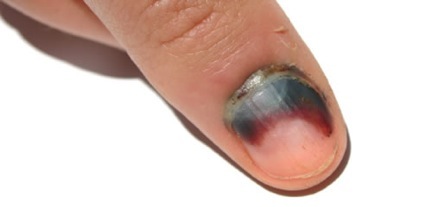The nail plate, or what we generally think of as the fingernail, grows from a section of soft tissue that actually helps the plate to form. It rests on the “nail bed,” which supports the plate, and the nail bed itself is attached to the bone at the tip of the finger.
 When a fingertip is crushed or otherwise fractured or lacerated, damage to the nail bed occurs. If this is not addressed (and sometimes even if it is), your nail plate can grow back deformed or even painful.
When a fingertip is crushed or otherwise fractured or lacerated, damage to the nail bed occurs. If this is not addressed (and sometimes even if it is), your nail plate can grow back deformed or even painful.
These usually are seen first in an urgent care or emergency room situation. Your healthcare provider likely will order X-rays to look for fractures that might need to be treated. If there is just a blood clot (or hematoma) under the nail, it might be able to be treated by just draining the hematoma with a small hole in the nail plate. However, a direct crush injury with a significant blood clot beneath the nail or a frank cut will require repair of the nail bed injury. Sometimes, a nail bed graft will be done. If there are other injuries to tendons, nerves, or bones, the procedure might be more extensive.
The better the repair, the more likely you are to regrow a relatively normal nail. Crush injuries cause scarring and can result in nail deformity. It takes 3-6 months for the nail to grow from the cuticle to the fingertip, so it is a bit of a waiting game.